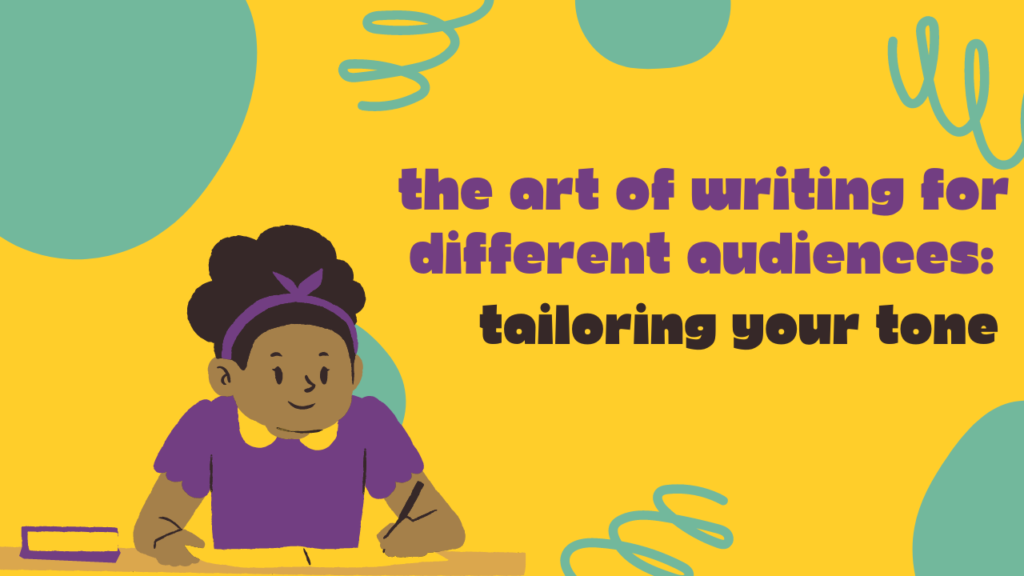Art simply means the way one expresses himself. Similarly, the art of writing is the way a person writes. The attitude in which a writer says his thoughts and emotions is known as tone. But can the tone always be the same? The answer is No. What influences the tone of a writer is his target audience.
The target audience includes the people for whom the content piece is written particularly. This article will give a sneak peek into the importance of tailoring tone while writing for different audiences. It will talk about the main elements that need to be customized while setting a tone.
Why is there a need to alter the tone?
Every reader cannot understand every piece of content; what favors a set of audience matters. For instance, a fifth-grade student will not be able to get complex words or jargon used in language. In the same way, a software developer will not tolerate sarcastic language. So, the art of writing should be flexible enough to adjust itself accordingly.
4 significant dimensions to tailor the tone
Certain factors, such as target audience, language, different mediums, etc., influence the content’s tone. Below are some important elements that a content writer should keep in mind so one can improve the art of writing.
Understanding the target audience:
If a content writer is writing something for marketing, then his ultimate aim is to reach his audience. In this scenario, he will be appreciated only when the target audience resonates with his art of writing. A variety of readers can be categorized on a different basis, and they have different tastes.
Among a wide range of searchers or audiences, it’s important to understand to whom the curated content is targeting. Since a piece of content cannot be suitable for every set of people. For example, in comparison to a youngster, an older adult may not be aware of trending abbreviations. So, it is suggested to keep in mind the target audience’s age group, educational level, goals, and interests.
Also Read: How to Nail a Killer Content Pitch: A Step-by-Step Guide
Choice of words:
It is said that words have the power to break or make. So, a writer should act judiciously while selecting words as it is a determining element affecting his art of writing. Audience-centric words should be used. The readers only stick to an article when they feel comfortable or connected with the play of words. A writer should refrain from using extreme and offending words.
Also, cultural sensitivity should be there in a piece of writing. Words that hurt the sentiments of a reader should be skipped. A writer can incorporate metaphors and idioms while writing for an elite class; otherwise, simple words can also work.
Tone:
The tone is the way a writer approaches a topic. The tone sets the background and influences the mood of the readers. It differs from topic to topic and as per the requirement of the industry or audience. A writer uses a suitable tone as per his assumption. If the writer finds a topic of professional importance, he writes formally. In a nutshell, the tone of writing can be formal, informal, exciting, humorous, etc.
Tailoring the tone as per platform:
The art of writing should be aware of the peculiar characteristics of various platforms. For example, a website requires more clear and straightforward content. A website cannot afford long paragraphs because a user gets drawn towards it with a relatively immediate need. So, making the user wait and beating around the bush are not wise things to do.
On the other hand, a blog can be more interactive and engaging in nature. In the same way, social media platforms have some unique characteristics; the tone should be more friendly and attention-grabbing. Because when people don’t find it attractive enough, they easily scroll down.
Conclusion
Evolution is one of the important fundamentals of this universe. A writer also evolves by altering his tone as per requirement. Writing by keeping in mind different platforms and audiences may seem an arduous task, but it improves the art of writing. By adjusting and adapting his tone, a writer hones his writing skills. This is what makes a writer versatile and flexible. These qualities are always valued in the content writing industry. They enhance the value of the art of writing of a content writer. So, the key is to keep tailoring the tone to tune well with the audience and platforms.
Follow Wabbithire for more updates.




